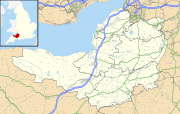Cannington Priory facts for kids
 |
|
| Monastery information | |
|---|---|
| Order | Benedictine |
| Established | c. 1138 |
| Disestablished | 1536 |
| People | |
| Founder(s) | Roger de Curci |
| Site | |
| Location | Cannington, Somerset, England |
Cannington Priory was a special kind of religious house for women called a Benedictine nunnery. It was built around the year 1138 in a place called Cannington, in Somerset, England. For many years, it was a home for nuns who followed the rules of Saint Benedict.
The priory was connected to the Church of St Mary nearby. It was closed down in 1536 as part of a big event in English history called the Dissolution of the Monasteries.
Contents
Cannington Priory: A Historic Nunnery
Cannington Priory was a place where nuns lived, prayed, and worked together. Nuns are women who dedicate their lives to God. They often live in communities called priories or abbeys. These communities follow specific rules, like those set out by Saint Benedict.
The first nuns at Cannington Priory came from Dorset, another county in England. Later, some of these nuns moved to Colwich Abbey. After the priory was closed, its buildings were changed into a large house. However, it later became a nunnery again for a short time before its final closure.
What Was a Priory?
A priory is a type of monastery or convent. It is a religious community where monks or nuns live. They follow a strict way of life. This life often includes prayer, study, and work. Priories were very important in medieval times. They were centers of learning and charity.
Nuns at a priory would spend their days in prayer. They also worked in gardens or copied books. They might have helped people in the local community. Their lives were usually quiet and focused on their faith.
Who Started Cannington Priory?
Cannington Priory was founded by a person named Roger de Curci. He was a wealthy and important person in the area. He likely wanted to support the church and provide a place for women to live a religious life. Building a priory was a common way for rich people to show their devotion in those times.
The Priory's End: The Dissolution
Cannington Priory was closed down in 1536. This was part of a major event known as the Dissolution of the Monasteries. This happened during the reign of King Henry VIII. The King decided to take control of all monasteries and priories in England.
The Dissolution meant that many religious houses were shut down. Their lands and wealth were taken by the Crown. The nuns and monks living there had to leave. This was a huge change for England and its religious life.
What Happened to the Buildings?
After Cannington Priory was dissolved, its buildings were often changed. Sometimes they were pulled down. Other times, they were turned into private homes or other buildings. In the case of Cannington Priory, some of its original structures were used to create a new building. This building is now known as Cannington Court.
What Can We See Today?
Today, you can still see parts of the old priory. These parts are now included within Cannington Court. This means that a piece of history is still standing. It reminds us of the Benedictine nuns who lived and prayed there centuries ago.


